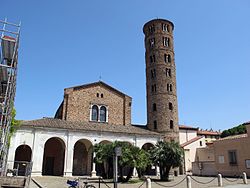Basilica of Sant' Apollinare Nuovo
| New Basilica of Saint Apollinaris Basilica di Sant'Apollinare Nuovo (in Italian) |
|
|---|---|
 |
|
| Basic information | |
| Location | Ravenna, Italy |
| Geographic coordinates | 44°24′51.4″N 12°12′21.4″E / 44.414278°N 12.205944°ECoordinates: 44°24′51.4″N 12°12′21.4″E / 44.414278°N 12.205944°E |
| Affiliation | Roman Catholic |
| Rite | Roman |
| Province | Archdiocese of Ravenna-Cervia |
| Country | Italy |
| Year consecrated | 6th century |
| Architectural description | |
| Architectural style | Early Christian, Byzantine |
| Groundbreaking | 505 |
| Official name: Early Christian Monuments of Ravenna | |
| Type | Cultural |
| Criteria | i, ii, iii, iv |
| Designated | 1996 (20th session) |
| Reference no. | 788 |
| State Party | Italy |
| Region | Europe and North America |
The Basilica of Sant' Apollinare Nuovo is a basilica church in Ravenna, Italy. It was erected by Ostrogoth King Theodoric the Great as his palace chapel during the first quarter of the 6th century (as attested to in the Liber Pontificalis). This Arian church was originally dedicated in 504 AD to "Christ the Redeemer".
It was reconsecrated in 561 AD, under the rule of the Byzantine emperor Justinian I, under the new name "Sanctus Martinus in Coelo Aureo" ("Saint Martin in Golden Heaven"). Suppressing the Arian cult, the church was dedicated to Saint Martin of Tours, a foe of Arianism. According to legend, Pope Gregory the Great ordered that the mosaics in the church be blackened, as their golden glory distracted worshipers from their prayers. The basilica was renamed again in 856 AD when relics of Saint Apollinaris were transferred from the Basilica of Sant'Apollinare in Classe because of the threat posed by frequent raids of pirates from the Adriatic Sea.
Its apse and atrium underwent modernization at various times, beginning in the 6th century with the destruction of mosaics whose themes were too overtly Arian or which expressed the king's glory, but the mosaics of the lateral walls, twenty-four columns with simplified Corinthian capitals, and an Ambo are preserved. On some columns, images of arms and hands can be seen, which are parts of figures once representing praying Goths and Theodoric's court, deleted in Byzantine times. Renovations (and alterations) were done to the mosaics in the mid-19th century by Felice Kibel. The present apse is a reconstruction after being damaged during World War I.
...
Wikipedia
